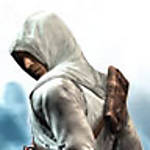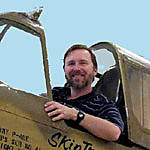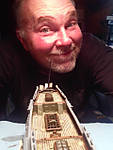Quoted Text
It did actually surprise me (at that point in the war) that anyone could amass so many 'Kills' ...
Hi Guys,
Aces, their kills, their frequency--one of my favorite topics. Jim and Straightedge commented on the number of kills in reference to a period of time. Yes, this subject can be amazing! I am not around my source material and running from memory, but I am certain of the general facts even though I can't always provide specifics.
Aside from comparisons, I shall not consider the German or the Japanese Experten, rather US and RAF pilots.
In Horrido! by Toliver and Constable, the chronicle of the Luftwaffe aces, the scores of the super aces were put into perspective. They noted that W. Molders, the first pilot with 100 kills, scored fewer kills per sortie than Gabreski and Johnson. That is despite flying in France, Battle of Britain, and Russia. Gabby's 28 kills included a triple and several double kills. I think the 56th's first mission was May '43. He went down 20 July, '44, with 300 hours of fighter missions. Gabby downed more than Molders per mission flown. His kills were against experienced pilots flying arguably better fighters with all the home-drome advantages, while tied to the bombers on escort duty. It is extrapolated that had Gabby flown as many sorties as Molders, his score would have surpassed the Luftwaffe legend. BTW, bomber crews' tours were by missions, fighter tours were by hours, 200/tour; I think only actual combat missions were counted. Gabby was on a second tour or voluntary extension. Ace of Aces Eric Hartman didn't fly his first mission until early 1943. The Star of Afrika, Hans-Jochim Marseille, Ace of Aces in the West, was a slow starter. In the Battle of Britain he downed 7, but lost 6 Bf-109s himself; he flew many missions in Afrika before his next kill, before he 'got his shooting eye.'
I've compared aces' kills with their total sorties and sorties that engaged in combat. Some only got a kill every 10-20 engagements, but flew hundreds of sorties. Others killed in every fight but only made contact a couple of times.
Consider Yeager. He got his 15 kills in only 5-7 fights, yet he flew dozens of missions during two tours. The US Navy's top ace David McCampbell got about 3/4 of his kills were in several multi-kill fights. Fifth Air Force P-47 ace Neale Kirby, the same. Pappy Boyington got his 22 Black Sheep kills in about two months in the big fights around and over Bougainville and Rabual. As did for Tommy Blackburn, Bob Hanson, and Ira Kepford.
In the RAF (of which I am familiar, not well-versed) we have Douglas Badder, who slew about a score of Nazis in several months during, and after, the Battle of Britain. Stanford Tuck, about the same. And let's recall "Killer" Clive Caldwell, top P-40 ace, who greased about two dozen over Egypt in obsolescent P-40s. Then there is the unofficial Western Ace of Aces, RAF's South African Paddle. He is believed to have downed some 50 Luftwaffe and Regina Aeronautica foes over Greece in 1941.
Consider this USAAF statistic from the Pacific: 65% of the Japanese shot down were killed by 15% of the fighter pilots. Like a former fighter jock once summed it up, "There are those who shoot, and those who are shot at!"
The factors in kills scored are many. I believe I have sifted out the main three as 1. Opportunity, 2. exposure, and 3. placement.
First, the 56th was in the thick of it from the beginning, when the Luftwaffe was still numerous and active. They broke its back from summer '43 until summer '44. After that, the LW was neutralized. Sure, they could and did occasionally put up tough fights, but they'd get pounded and have to hide in the revetments to reconstitute their ranks and stockpile dwindling fuel supplies. And in the autumn and early winter of '44, Galland was hoarding his strength for his planned Big Blow. Yeager and Bud Anderson flew their final sortie together. Considering they'd been months without seeing a German, they decided to take a joyride around Europe; they got back to base to find they had missed the biggest dogfight of the Western Front!
The second factor that leads directly to opportunity was missions flown. Obviously. Yet, turns out that most of our 8th AF fighter pilots flew their entire tour without ever contacting an enemy.
Third factor, placement, was the period of the war, or the area the fighting was in. Consider the Corsair/Hellcat debate! The F6F shot down three times the number the F4U did, even though the Corsair was technically slightly better. Why? Because the Corsair was ruled unfit for carrier ops and regulated to ground-based USN and Marine squadrons. Thus, in the big fights after the Solomons campaign, mid-'43 to mid '45 the Corsair was not where the air-to-air was taking place, when about 3/4 of all Japanese planes were shot down. Where F4U's did meet the Japanese, they did as well or better than F6F units. Thus the Corsair is a perfect example of all three factors.
Joe Foss, USMC, personifies this. He arrived at Guadalcanal in October '42 and blazed his way through 25 kills in about six weeks flying obsolescent Wildcats from most primitive conditions against the best that Japan had. Boyington, Kepford, Hanson, James Sweatt and several USN Hellcat aces ran up their big scores in just a few weeks, or battles.
And then they were sent home to train others, or ended in tragedy.
In short, nothing odd about big scoreboards in short (relatively) periods. We can only speculate about Allied pilots' scores if they were kept in near continual combat (exposure, placement) like their foes, or if the foes had the ability to field the vast numbers of aircraft that we did (opportunity).








































